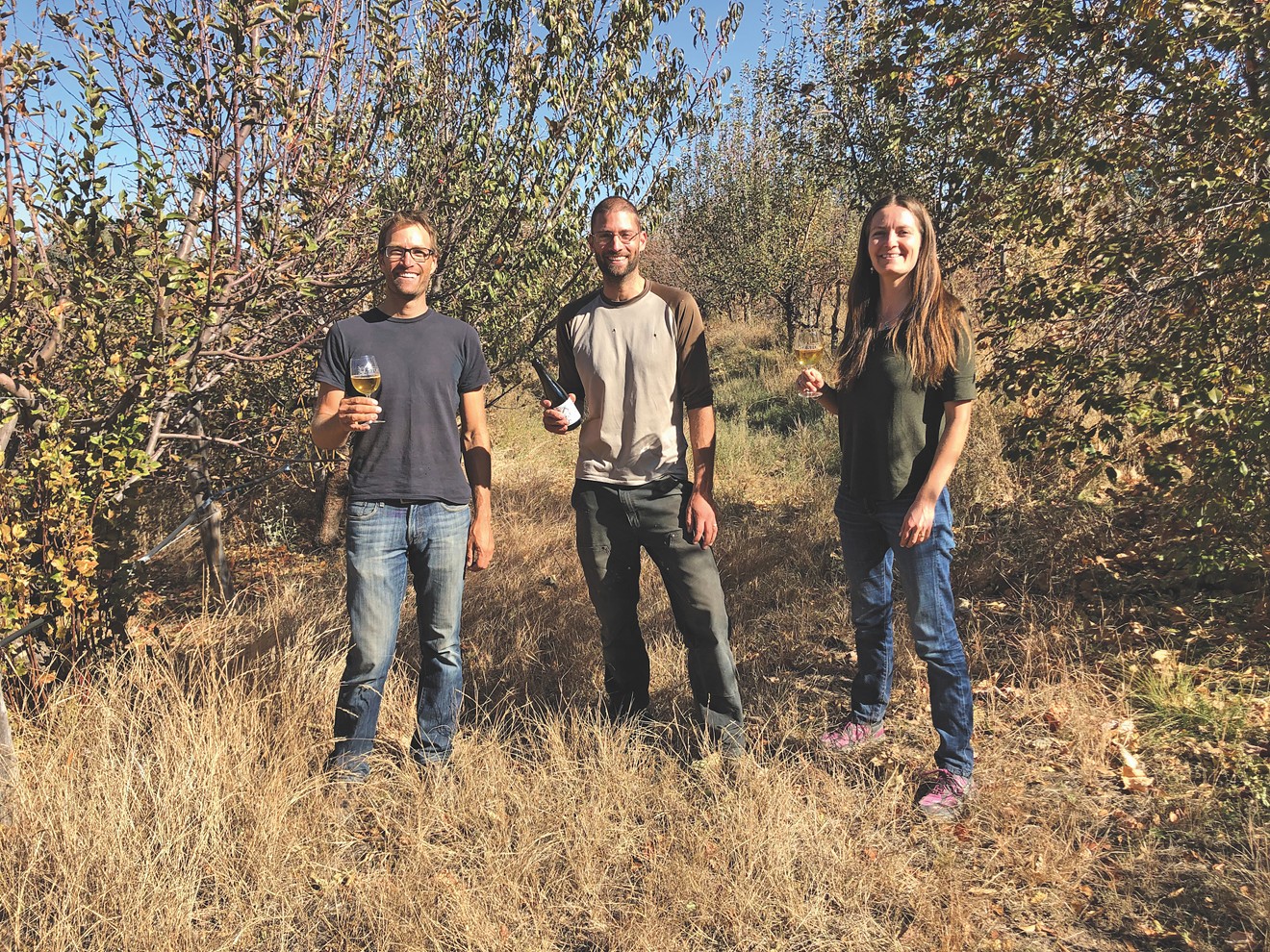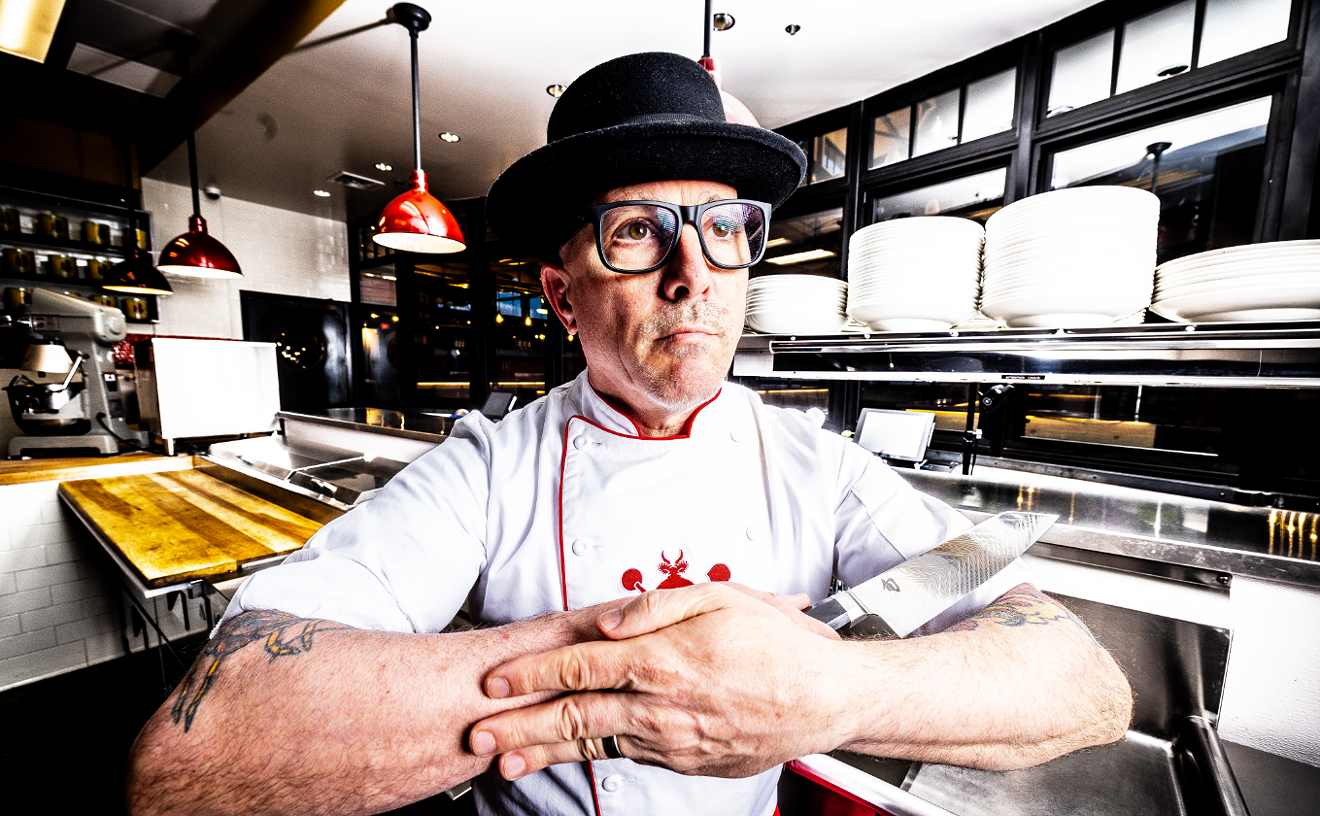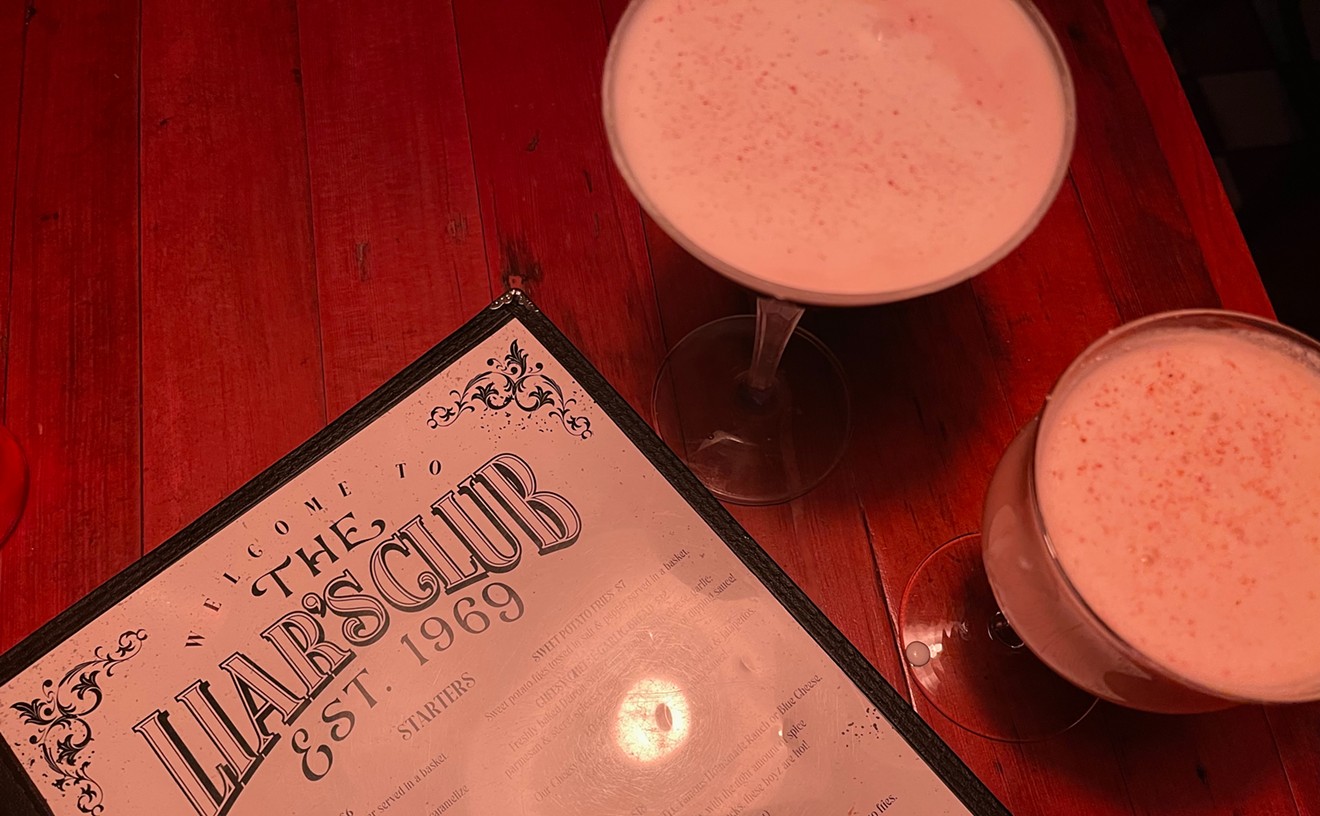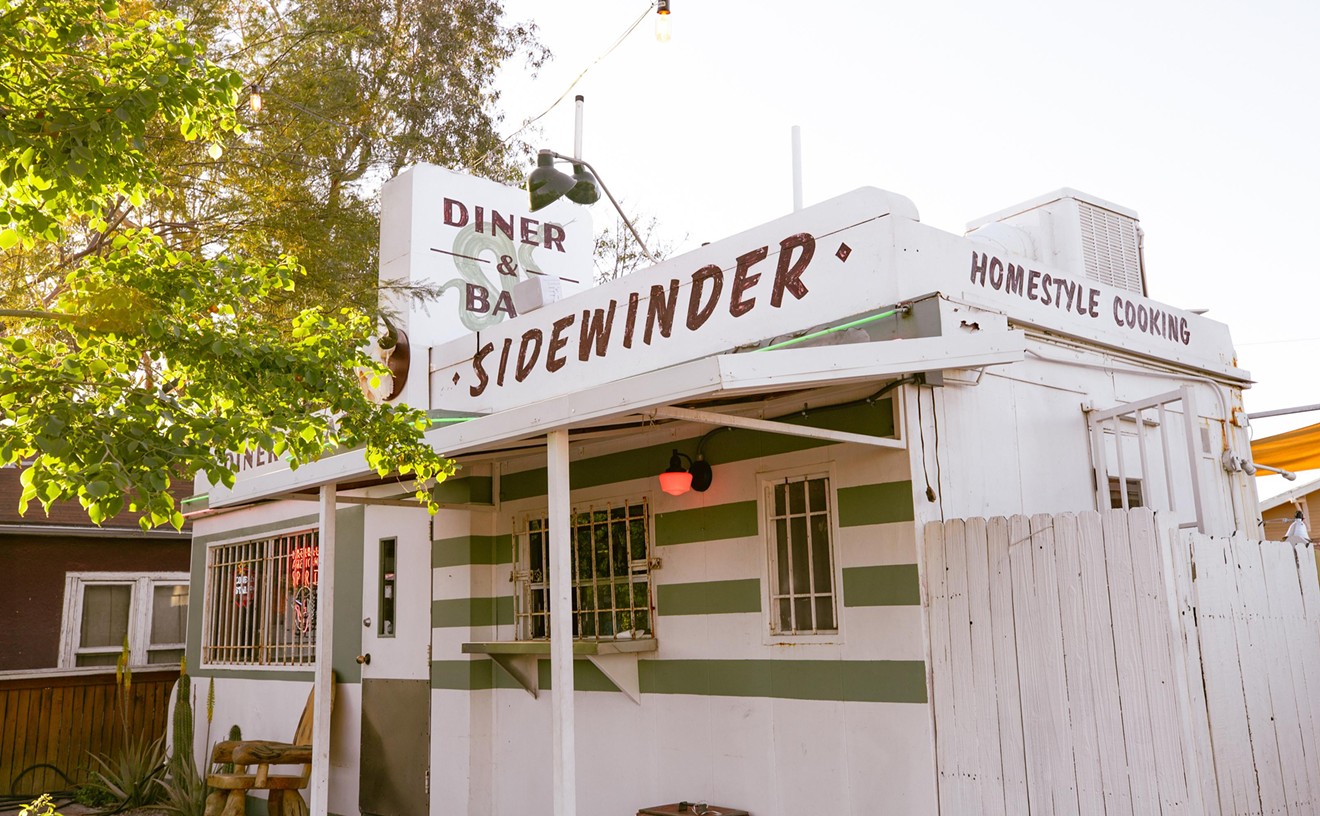He’s thinking about trees, but not the pines. He’s thinking about gold, but not the precious metal struck here in ages past, drawing a flood-tide of settlers to these wilds near Prescott in the late 19th century. What Kanin seeks is far more fleeting and beautiful: lost apples.
Kanin, who’s 37, drives deeper into the mountains. He tells me about his past academic projects — he has a Ph.D. in apple population genetics — and his current project, a Prescott-area cidery called Stoic Cider. His cidery produces dry, wine-inspired ciders from the wild pre-WWII apple orchards of northern Arizona, from apples harvested from an orchard on his farm, and from alluring apple varieties from the greater American West.
His wife and Stoic co-owner, Tierney Routson, a 31-year-old biologist with long brown hair and a North Dakota drawl, listens in the back as Kanin speaks.
“This is not an apple-growing area,” Kanin says, his truck now descending, startling mountain bluebirds that dart through the early November sunshine. “I didn’t grow up in an apple culture, per se. Most of these trees don’t produce fruit every year, because we’re in a super-marginal area, and these heritage trees are hardly being cared for at all.”
Kanin parks on the side of the powdery grade. Tierney grabs a Nalgene, puts on a straw hat. The two scientists start hiking downhill through pines, on a mission as immersed in the open world as the one they met on in 2012 — back when they were clipping forage on the Navajo Nation to help extrapolate grazing rates for the tribe and Bureau of Indian Affairs. Kanin twists his tall frame through scratchy brush with ease, with unconscious familiarity, having grown up on a dairy farm to the north encircled by similar woods. Ahead, his lean figure presses through, still lecturing, squinting in wiry glasses against the cool sun. Brambles whip as we squeeze past. The air is sharp and clear out over the treed valley we are entering.
And then, five minutes downhill, like a bolt of lightning illuminating a dark landscape, you realize the orchard has risen around you. Short trees under tall pines. Leaves mostly fallen. A low, broken stone pillar once part of a home. And here, the past of gold rushes and settlers lives on in faint echo — a forgotten orchard in the Bradshaws, half reclaimed by lofty pines, looking like the white ruins of a Greek temple.
Kanin and Tierney peer into the orchard’s first treetops, looking for fruit.
At the turn of the 20th century, when the American frontier had recently closed and Arizona was a territory, homesteaders planted apples for jam, sauce, baking, cider, cellaring, and eating fresh off the tree. They planted separate apple varieties tailored to each purpose. They planted so that these varieties would ripen one and then another, bettering their odds of a steady supply. Today, these settlers have passed from the land. But in some places, their orchards remain.
The lost orchard in the Bradshaw Mountains is one of Kanin’s favorites. He and Tierney call it Big Bug Orchard, after its stream. In 2017, Big Bug Orchard produced a bumper crop of ripe fruit. So the Stoic Cider team picked boxes, trucked them 45 minutes north, and made cider.
The idea of an Arizona cidery feels inherently strange. The most popular beverages here are beer, cocktails, and agave-based spirits. Apples and hard cider are more linked in the greater American mind with states like Washington and New York.
Though apples don’t grow in Arizona’s thumbprint landscape, the Sonoran Desert, they have been an important food in northern Arizona’s high desert since before refrigeration, ice, and global supply chains. Homesteaders planted apples because they needed food. They planted them, too, because in order to secure land under the expansion-minded (and ethically suspect, given the indigenous populations) Homestead Acts, homesteaders had to show permanence; raising orchards meant food, yes, but also proof of long-term intentions.
Stoic Cider is at its most vital when entwined with Arizona apples, with land and history.
Big Bug Orchard, for instance, is just one historic orchard Kanin visits, often with one or more fellow Stoic co-founders. It’s just one point in the vast constellation of pre-WWII apple orchards he has checked on in northern Arizona and slightly beyond. Most of these orchards, 43 in all, are “feral,” meaning no longer tended.
Nature being complex, feral orchards arise from many sources other than vanished homesteaders.
“The term ‘feral apple’ could mean a lot of different things,” says New York-based pomologist Gregory Peck, an apple scholar with Cornell University’s Hard Cider Resources program. He points to wild orchards descended from those planted by missionaries, those active in the early, post-contact days of Eusebio Francisco Kino. There’s evidence that indigenous people propagated these apple trees beyond their initial plantings. Their seeds certainly have also been spread by animals, leading to new stands of apple trees. Peck notes that feral orchards can be abandoned commercial orchards, but these are uncommon in the Southwest, where climate has prevented large-scale commercial apple growing.
From time to time, these far-flung feral apple orchards furnish Stoic Cider with unusual apple varieties to be pressed to juice, inoculated with yeast, changed by time, and slowly transformed into special, micro-batch cider vintages.
Some historic orchards have provided Kanin with outlandish varieties for his own orchard, a multi-decade work in progress. Since he was young, he and his brother Cody — another Stoic co-founder — have been grafting apple trees near the Prescott farm of their birth.
“We’re always co-conspirators on these projects,” says Cody, a climatologist, who also does non-apple field work in the Rocky Mountains. “We were both going to these historic orchards. We were both grafting since we were 12.”
Kanin started orchard production 15 years ago, when he grafted his first tree onto the 60-acre farm his parents founded in 1980. Today, his nursery has grown to 1,500 trees, his orchard to 160. Under the Stoic Cider label, found on bottles from Flagstaff to Phoenix, Kanin, together with co-founders Tierney, Cody, and Clare Stielstra (Cody’s wife, a hydrologist), has released some 13 cider vintages. They press and ferment apple juice in a squat, tent-like structure with a curved concrete ceiling and graphite-colored adobe walls; the fireproof structure was initially built by the brothers’ dad, Don Routson, as an experimental farm kitchen.
Open since 2017, Stoic is a small-batch, “apple-forward” cidery that makes limited-availability, high-terroir cider using feral fruit and fruit from its farm orchard. Stoic also crafts bigger, more frequent, more financially viable batches from unique apples sourced from boutique orchards across the American West.
Like the mythical creature and young city, the Phoenix cider scene has, in the past few years, arisen from virtually nothing. Cider Corps, Desert Cider House, Desert Rock, and Crush Craft Cider are all making cider in the metro area.
But there’s a reason you can find Stoic Cider at elite restaurants like FnB, or sip frosty pours at thoughtful tap rooms like The Wandering Tortoise. What Stoic Cider is doing is unique, though nationally a select few cideries are using feral fruit. Locally, nobody else is deploying the savvy of founder-scientists, grafting from lost orchards, growing hundreds of varieties, and venturing into the woods to cleave to the apple’s soul.

Kanin Routson climbs a feral pear tree to pick and assay fruit for perry-making potential.
Tierney Routson
Kanin looks to a few new trees. Searching them, he starts to speak of the apple rows across Big Bug Creek, invisible from our vantage. He speaks of how his brother’s skill set has helped with orchards like these, particularly his fluency with tree-ring dating. Cody can peer at a concentric spiral of apple tree rings and pinpoint tree age. “So we came in here and cored the trees,” Kanin says, recalling a past visit, “and aged the trees within plus or minus a year of when they were planted. I think it was 1904.”
Seeing something, Kanin strides away.
He reaches a stodgy tree. Planting his feet, he climbs its trunk, grasping and stepping his way to the top. As he stretches for fruit, a faraway dirt bike howls down a mountain. Kanin plucks a few pears, tosses them to Tierney. “This is one of the coolest orchards we interact with,” he says. Tierney draws a knife, slices pear wedges.
The three of us taste them. The Routsons also make cider from pears, a drink known as perry. This feral pear brings an absolute hurricane of tannins, seeming to vaporize every last speck of moisture from your mouth. It is so voraciously drying that you can only smile.
“It’s got some serious tannin,” Kanin chuckles.
“Oh yeah!” Tierney says. “Like, you need a moment after this one.”
“That would be a good thing to make a perry out of,” Kanin replies.
Tierney nods, appraising the skeletal feral pear tree. “They’re not getting watered and they’re still producing fruit. It’s notable that this tree had ... pears when nothing else does. That’s cool. That’s an adaptation.”
Kanin turns to me. “That’s something that we’d be potentially interested in for our purposes — which is to make the best cider.”
“With a sense of place,” Tierney adds.
Big Bug Orchard is the kind of meaningful place they hope to express through cider. Kanin first came here more than a decade ago, for academic research. He got into apples partly through the historic orchard mapping led by Gary Nabhan and Native Seeds/SEARCH, as well as through Michael Pollan’s book The Botany of Desire: A Plant’s-Eye View of the World.
Historic orchards and arcane apple varieties informed his central projects at Northern Arizona University (where he obtained his master’s degree) and University of Arizona (where he earned a Ph.D.). A lot of his research has been funded by the National Center for Genetic Resources Preservation, an arm of the U.S. Department of Agriculture. Previously, in Big Bug Orchard, Kanin genetically sampled a subset of its 170 apple trees, identifying seven known varieties (Winter Banana, King David, Lowland Raspberry, Red Delicious, Senator, Wagener, and Westfield Seek No Further), plus seven unknown.
The Routson brothers’ tree ring research dating Big Bug to 1904 is crucial. First, Kanin is only interested in orchards planted before the 1930s, when, thanks to the advent of cold storage that realized the possibility of growing for faraway markets, a fervor for Red Delicious swept the nation, replacing older apple varieties. Orchards from before then are more likely to contain the rarer of the 6,654 apple varieties that USDA pomologist W.H. Ragan identified in U.S. literature between 1804 and 1904. Second, conventional apple trees live for between 100 and 150 years. At 115 years old, Big Bug Orchard won’t be producing forever.
Kanin and Tierney meander downhill, inspecting trees, talking cider.
Though they’ve visited this orchard many times over the years, they often discover new fruit — due to how settlers planted for staggered ripening, and because feral trees, especially old ones, may go years without fruiting. Nearing the creek, they start to approach the long rows of apple trees nestled into its crook — the main, rowed stretch of the orchard. And now, they really start to look for hardy-skinned gold.

The adobe-walled cidery of Stoic Cider was first built on the family farm as an experimental kitchen.
Chris Malloy
In 2018, they plucked heritage apples from community trees in Flagstaff neighborhoods, and later released the cider in two slightly divergent batches.
In 2019, the four scientists unleashed a tart, bourbon-barrel-aged perry, cold-fermented from pears foraged two years earlier in Skull Valley.
This month, Stoic is releasing a cider made using apples from trees grafted onto its farm from Big Bug Orchard — and other lost orchards across Arizona. Kanin has grafted, for instance, Arkansas Black from an orchard near Oak Creek that dates to 1912. In grafting some 100 trees from orchards across Arizona, representing 29 varieties, Kanin has raised a fledgling apple farm to furnish his cidery. Beyond these grafted trees, his farm contains another 239 varieties, many from beyond Arizona. These include rare finds, like the Otterson crabapple, with its watercolor-red flesh and black trees, plus the seedlings of the wild species Malus sieversii from Kazakhstan, where the first apples evolved.
This fall and winter, Kanin will be transplanting young nursery trees to his orchard, where more mature trees are moved as they near fruiting age. Steadily, the trees he has grafted over the last 15 years are growing. Still, some, especially those grafted from older trees, can take a while to fruit. “Some apple trees, you graft them, and three years later they’re producing fruit,” Kanin says. “Some apple trees, like Westfield Seek No Further … it’s like 10 years later.”
The slow ripening of older grafted trees and the availability limitations of feral trees, the former being an obstacle that will lessen with time, cause Stoic to look for supplemental sources for the bulk of its cider-making. To augment prized small-batch releases, Kanin sources heirloom apples from orchards across the West.
He sources distinctive apples from distinctive orchards that exist apart from Stoic, growing in their own reaches of the country. Roxbury Russet. King David. Esopus Spitzenburg. Newtown Pippan.
Kanin favors stranger apples. He did his Ph.D. research on Malus fusca, a wild apple species native to the New World. This apple isn’t among the 16,000 varieties of Malus domestica, the domesticated apple, which is the common apple native to the Old World. Malus fusca is one of the 27 other apple species. “It’s about the size of your little fingernail,” he says.
In terms of cider style, Kanin and Tierney hesitate to align with a tradition. Stoic Ciders aren’t like ciders from Basque country, Normandy, or England. They fall within the American craft cider revival sparked earlier this decade, a movement so young there are few established rules beyond those of nature. “We position ourselves as an apple-based cidery,” Tierney says. “That’s the heart of what we do, is what apple we’re using and why.”
When pressing apples and fermenting juice in the adobe-walled cidery on their hilly family farm, the goal is to develop flavor over long, cold fermentations, keep ciders dry, and let the apples shine. “We’re using very specific fruit … and doing very clean fermentations,” Kanin explains. “We want our fermentations to be transparent, so you can taste as much of the apple quality as possible. You’re really celebrating the terroir, the varietal characteristics.”
When using wild fruit, they rarely use cider apples, meaning bitter, tannic apple varieties seen as poor for eating and ideal for cider-making. “All these heritage orchards,” Kanin says, “they were planting for mostly fresh use.”

Kanin and Tierney Routson get ready to go downhill and cross Big Bug Creek to the main apple orchard.
Chris Malloy
Since opening, Stoic Cider has released a straw-gold cider made from Newtown Pippan apples from Oregon — a cider perfumed with fresh hops grown on the 60-acre Stoic farm.
The cidery has made a vintage from Colorado heirloom apples and Dolgo crabapples, a savory blend carrying the faint musk of Arizona oak, chopped from the Stoic farm and toasted until its vanilla notes flared to life.
The team of four scientists has aged four-apple blends on lees, residual yeast particles, just like the Champagnes their ciders often faintly resemble.
They have made single-varietal cider from Golden Russets, one of the popular cider varieties in the 18th century, back when Benjamin Franklin was waxing cerebral on the good stuff, his cider maxims still echoing today.
But still, Stoic Cider is best when making micro batches from wild apples, or from apples picked from historic trees grafted onto the Stoic farm. And so, in the dying days of apple season, Kanin and Tierney burst into the creek-side apple orchard with great anticipation. Will they find enough apples to make yet another micro batch from lost fruit? Will Big Bug Orchard be as teeming and resplendent as it was two years ago?
Not today. On the 120 or so surviving trees, they don’t find one apple.
In the eyes of Peck, the Cornell pomologist and cider expert, there is great intrigue and potential value in how people like Kanin are grafting “found genotypes” of apple trees onto their orchards, for use in cider. “One of the really exciting things for the U.S. Cider industry is what Kanin and others are doing,” Peck says. “It’ll be interesting to see if any of these found genotypes become commercially important.”
No apples in the secret mountain orchard? No problem.
Kanin has already grafted trees from Big Bug Orchard onto the Stoic farm, meaning that this orchard, when its time has come, will live on. It and the people who planted it will be preserved, in the faint way that things are, by the fruit that its descendant trees bear. Fruit that, the apple geneticist and biologist hope, will one day be commercially offered, with the rest of the lost-orchard Stoic batches, to members of a cider club.
“Isn’t it lovely!” Tierney says, drifting through the orchard, smiling in the sun. “120-year-old apple trees just existing in the middle of the forest!”
Note: You can find Stoic Cider in the Valley at the following places. Right now, a few carry Stoic's two-year-anniversary cider, fermented from a blend of offbeat apples grown on the Stoic farm and aged for a year on Arizona oak. Availability of this and other ciders varies greatly, so call ahead.
Arcadia Premium
AZ Wine Company
Bottleshop 48
Dust Cutter
First Draft Book Bar
FnB
GenuWine
ODV Wine
Old Ellsworth Brewing Company
Pa’la
The Sleepy Whale
The Theodore
Total Wine & More (Valley-wide)
The Wandering Tortoise
Whole Foods (Camelback, Chandler, Scottsdale, Tempe)

















